Royal Lyceum Theatre

The Royal Lyceum Theatre is a 658-seat theatre in the city of Edinburgh, Scotland, named after the Theatre Royal Lyceum and English Opera House, the residence at the time of legendary Shakespearean actor Henry Irving. It was built in 1883 by architect C. J. Phipps at a cost of £17,000 on behalf of James B. Howard and Fred. W. P. Wyndham, two theatrical managers and performers whose partnership became the renowned Howard & Wyndham Ltd created in 1895 by Michael Simons of Glasgow.With only four minor refurbishments, in 1929, 1977, 1991, and 1996, the Royal Lyceum remains one of the most original and unaltered of the architect's works.Opening night was 10 September 1883 with a performance of Much Ado About Nothing by the company of the London Lyceum Theatre, and starring Henry Irving and Ellen Terry.In 1965, the building was purchased by the Edinburgh Corporation from Meyer Oppenheim to house the newly formed Royal Lyceum Theatre Company, who are now the permanent residents, leasing it from the local council.The Royal Lyceum has been one of the principal venues for the Edinburgh International Festival since the festival's inception in 1947, its owners renting out the building for three weeks every August for visiting companies, and often for a further week to Fringe companies.The Royal Lyceum has primarily been known for its provision of drama. However, it has also presented some significant opera, from the first tours of Carl Rosa in the latter part of the 19th century, through to the early decades of Scottish Opera in the 1960s and 1970s. Some important operas received their first Scottish performance at the Lyceum, including Madam Butterfly, Manon and Die Meistersinger.The theatre was the first in Britain to be fitted with an iron safety curtain, and the first in Scotland to use electricity for house lighting.David Greig took over from Mark Thomson as artistic director in 2016.
Excerpt from the Wikipedia article Royal Lyceum Theatre (License: CC BY-SA 3.0, Authors, Images).Royal Lyceum Theatre
Grindlay Street, City of Edinburgh Tollcross
Geographical coordinates (GPS) Address Phone number Website External links Nearby Places Show on map
Geographical coordinates (GPS)
| Latitude | Longitude |
|---|---|
| N 55.946944444444 ° | E -3.2044444444444 ° |
Address
Royal Lyceum Theatre (The Lyceum)
Grindlay Street 30b
EH3 9AX City of Edinburgh, Tollcross
Scotland, United Kingdom
Open on Google Maps








